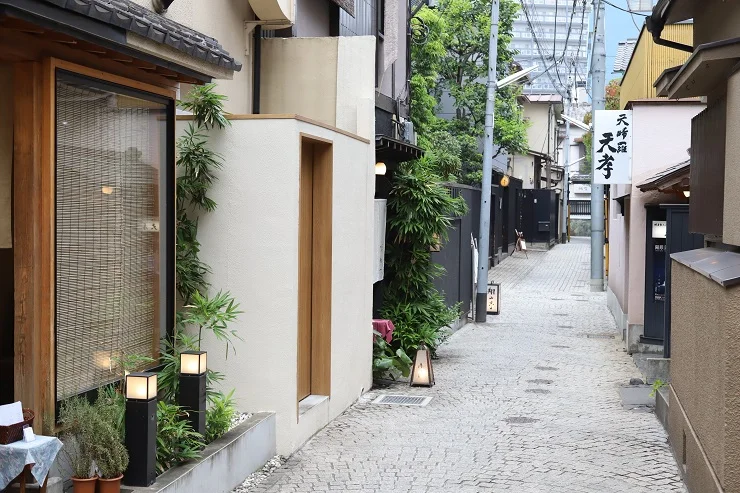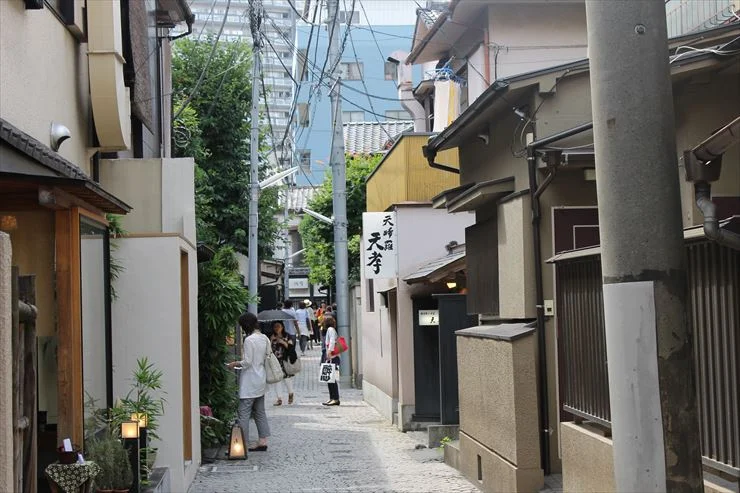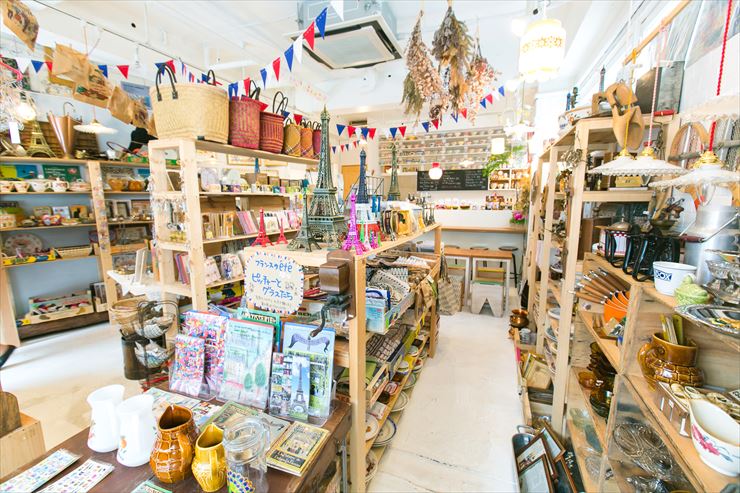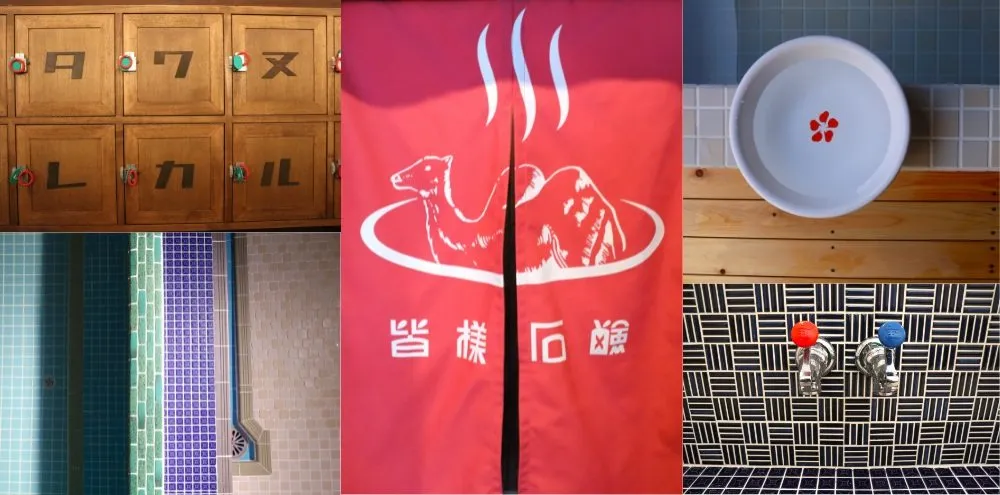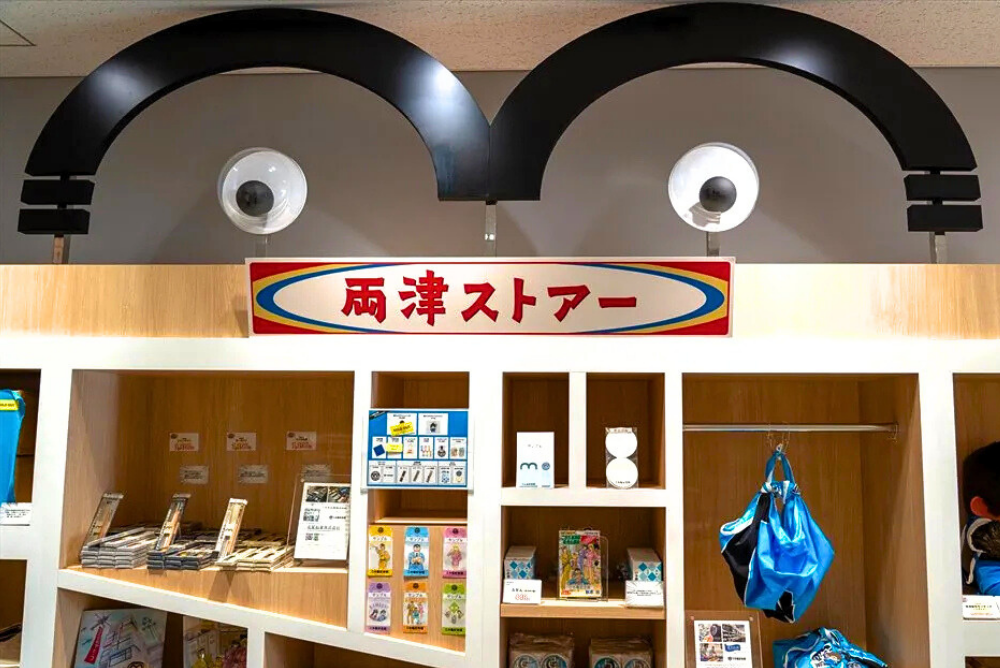
KAGURAZAKA
KAGURAZAKA

Getting off JR Sobu Line, at Iidabashi Station and crossing Ushigome Bridge over the famed Sotobori moat, will bring you to the base of Kagurazaka, a short slope leading approximately 400 meters up the hill from Kagurazaka-shita crossing.
Kinozen, an old Japanese sweets shop, sits at the bottom of the slope. An all-time favorite for students, past and present, of nearby Tokyo University of Science and Hosei University. As you leisurely climb the narrow street lined with shops, you will find many stores preserving Japanese tradition. They stand proud, yet lay hidden among their more modern counterparts.
So now let’s go on an excursion in search of the remnants of the chic hanamachi* to get a taste of the purely Japanese mood that once flourished in this area.
Kagurazaka - The Scent of Nightlife Long Past
Kagurazaka – The Scent of Nightlife Long Past
During the Edo period (1603-1867), warlords’ mansions and tradesmens’ townhouses stood side by side along the slopes of Kagurazaka. The area gradually became busier as nightlife activity increased towards the end of the Meiji period (1868-1912), when classic Japanese restaurants sprang up with geisha*, specifically trained to entertain select customers. The world of geisha, or karyukai* in Japanese, reached its peak in Kagurazaka between the Taisho period (1912-1926) and the beginning of the Showa period (1926-1988) as one of the most famous hanamachi districts of Tokyo. It is said that at one time, over 650 geisha could be found entertaining customers on a single night. Even former prime minister Kakuei Tanaka frequented Kagurazaka, perhaps because the Kagurazaka karyukai was known for familiar feel and its unpretentious geisha. Today there are still over a dozen traditional restaurants lining the alleys of Kagurazaka.
Kagurazaka was also a favorite among well-known writers of the period. Writers living in the neighborhood would come out to the town to enjoy the evening or simply to take a stroll. There were also several inns offering rooms to novelists and scriptwriters in need of a quiet environment in which to write. Kagurazaka geisha were often times the icons of such writers as well as people in the movie business.
Slopes and Alleys World
War II devastated the Kagurazaka community. Today, even the buildings perceived to be old only have a history of about fifty years. However, the sloping streets and small blocks running off to the sides retained the original Edo period street layout, and people rebuilt the town to make the most of the original. This is the reason the town is still thought to preserve the flavor of the Edo, Meiji and Taisho eras. Karyukai was revived and Kagurazaka became animated once again with writers and artists drawn anew to its slopes and alleys.
Taking a turn off the main Kagurazaka Street and into a small alleyway, a narrow passage, looking as though inserted between black wooden fences, brings to mind the elegant ambience of yesteryear. Alleys are the delight of Kagurazaka, though, realistically speaking they are a safety hazard. Then again, look at Italy, France, Greece or Spain. Narrow alleyways have always been an asset to both local and national tourism.
Kagurazaka is a network of countless slopes and tiny lanes lined with black fences. One is easily dazed by its labyrinth. These alleys were once home to only the karyukai. Now that people have rediscovered their charm, eateries are found in some of their deepest reaches. In the old days though, not so many outsiders entered the alleys, as karyukai life remained indifferent to ordinary visiting folk. Classical restaurants kept the alleys clean and were devoted to displaying an air of sophistication to welcome their mature guests. For the most part, the alleys today still give that quiet, refined atmosphere of days lost.
Gourmet Heaven
Karyukai is a place of extravagance. One can eat and shop at the finest shops including a number of spots for fine dining.
Across from Bishamonten Temple is “Kagurazaka Goju-ban,” a meat bun shop, so popular that there is always a long queue out front.
Also, with L’Institut Franco-Japonais de Tokyo located nearby, there are many French people in the area, with an ample number of French restaurants to accomodate their culinary desires. “Le Bretagne” is famous for its buckwheat crepes and another popular French venue, “Fromagerie Alpage,” specializes in cheese.
Naturally, Japanese cuisine including sushi abounds in Kagurazaka, but aside from French and Japanese restaurants there are a number of other ethnic eateries, such as Italian, Chinese, and Turkish.
Shinto Shrines and Buddhist Temples

The Bishamonten (Zenkokuji) Temple is located at the top of Kagurazaka Street. The faithful have always fondly called it “Bishamon-sama of Kagurazaka.” A pair of stone-carved guardian tigers sit in the courtyard of Bishamonten, once the center of activity in Edo-period Kagurazaka.
The surroundings near Akagi Shrine has blended themself in completely with the daily life of Kagurazaka residents. At night, it gives out a mystical feel as the lanterns light up the darkness with a bright red glow.
Kagurazaka Tomorrow
No town is resistant to change, however. Sooner or later, the once familiar mood will be replaced by another. Kagurazaka was once popular only among a handful of privileged visitors to karyukai, but today it is open to everyone. Old townhouses have been replaced by large apartment buildings. Historic shops disappeared as contemporary versions emerged and as a result, there are first-rate stores here, as well as more competitive businesses, meaning students enjoy this town just as much as local and visiting elderly citizens do. Japanese, French and Italian cuisines live side-by-side, yet what has always made Kagurazaka unique are the karyukai alleys and the Edo-period sloping streets. Today’s Kagurazaka is a potpourri of all generations and ethnic variation.
The Sotobori moat near Iidabashi Station was once the entrance to Kagurazaka and also a defensive point of Edo Castle. Now, an aquatic restaurant named “Canal Cafe” sits upon its waters, and the contrasting view of high-rise buildings and the carp and ducks swimming close by give the feel of being in a true urban oasis. Let’s spend some time in this little Shangri-la, oblivious to the hustle and bustle of the surrounding city life, before heading home.

*Geisha – woman trained in Japanese dance and traditional Japanese musical instruments, such as shamisen, providing entertainment at banquets.
*Hanamachi – the vicinity frequented by customers entertained by geisha.
*Karyukai – the world of the geisha.
